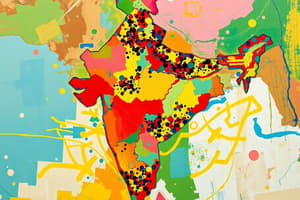Podcast
Questions and Answers
Which rivers traverse India and nourish the land?
Which rivers traverse India and nourish the land?
- Nile and Yangtze
- Amazon and Nile
- Mississippi and Danube
- Ganges, Yamuna, and Brahmaputra (correct)
Where is the northernmost point of India located?
Where is the northernmost point of India located?
- Kanyakumari
- Kibithu (correct)
- Arunachal Pradesh
- Tamil Nadu
Which desert stretches across Rajasthan, Haryana, and Punjab?
Which desert stretches across Rajasthan, Haryana, and Punjab?
- Thar Desert (correct)
- Atacama Desert
- Sahara Desert
- Gobi Desert
Where are Mount Everest, K2, and Kangchenjunga located?
Where are Mount Everest, K2, and Kangchenjunga located?
Which part of India is home to the majority of the population?
Which part of India is home to the majority of the population?
What bodies of water define India's western and eastern boundaries?
What bodies of water define India's western and eastern boundaries?
What geographical factor contributes to the lower population density in southern India?
What geographical factor contributes to the lower population density in southern India?
Which country does India NOT share a land border with?
Which country does India NOT share a land border with?
In terms of land area, how does India compare to the United States and Australia?
In terms of land area, how does India compare to the United States and Australia?
How many time zones is India divided into?
How many time zones is India divided into?
Which time zone is specifically designated for the Andaman and Nicobar Islands?
Which time zone is specifically designated for the Andaman and Nicobar Islands?
Why does India have multiple time zones instead of a single one?
Why does India have multiple time zones instead of a single one?
Flashcards are hidden until you start studying
Study Notes
India's Size and Location
India is a vast, diverse nation situated in South Asia, with a unique blend of geographical features, population distribution, and complex relationships with its neighbors. Understanding these elements helps us grasp the extent and intricacies of India's size and location.
Geographical Features
India is home to a wide variety of landscapes, from the snow-capped Himalayas in the north to the sandy beaches of the Indian Ocean in the south. The northernmost point is Kibithu in the state of Arunachal Pradesh, while Kanyakumari in the state of Tamil Nadu marks the southern tip. The country's western limits are defined by the Arabian Sea, and the eastern boundaries are set by the Bay of Bengal.
The Ganges, Yamuna, and Brahmaputra rivers traverse the country, nourishing the land and shaping the landscape. Three of the world's highest peaks—Mount Everest, K2, and Kangchenjunga—are located in India's northern territories, bordering Nepal and Bhutan. The Thar Desert, also known as the Great Indian Desert, stretches across the states of Rajasthan, Haryana, and Punjab.
Population Distribution
India boasts a massive, diverse population of over 1.4 billion people, distributed across its vast expanse. The northern and central parts of the country are home to the majority of India's population, particularly the Ganges Plain and the fertile Indo-Gangetic Plain. The southern regions, including the states of Kerala, Tamil Nadu, and Karnataka, have a comparatively lower population density due to the hilly terrain and limited arable land.
Neighboring Countries
India shares land borders with seven countries: Pakistan to the west, China, Bhutan, and Nepal to the north, and Bangladesh, Myanmar, and Afghanistan to the east. Its maritime borders extend to the Bay of Bengal, Arabian Sea, and Indian Ocean. The country's location at the crossroads of Asia makes it a significant global player, with deep historical, cultural, and political ties to its neighbors.
Land Area
Covering an area of over 3.28 million square kilometers, India is the seventh-largest country in the world by land area. It is slightly smaller than the United States and slightly larger than Australia. Its relatively large size makes India's administration and logistics complex, driving the need for efficient infrastructure and governance.
Time Zones
India does not have a single time zone; instead, it is divided into five time zones to account for the country's vast geographical extent. The five time zones are:
- Indian Standard Time (IST) for most of the country
- Indian Peninsular Standard Time (IPST) for the Andaman and Nicobar Islands
- Andaman, Nicobar, and Comorin Time (ANCT) for the island territory of Lakshadweep
- IST-NST (Nagar Haveli and Daman and Diu Standard Time) for the union territories of Daman and Diu and Dadra and Nagar Haveli
- IST-UT (Uttrakhand Time) for the northern state of Uttarakhand
This division of time zones allows India to align its schedules with various parts of the world, enabling seamless communication and trade across its vast territory.
Studying That Suits You
Use AI to generate personalized quizzes and flashcards to suit your learning preferences.




